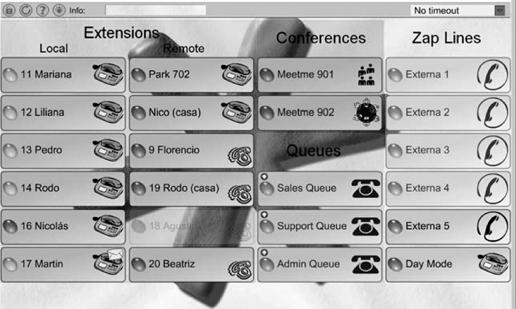Call Files
Call files allow you to create calls through the Linux shell. These powerful events are triggered by depositing a .call file in the directory /var/spool/asterisk/outgoing/. The actual name of the file does not matter, but it’s good form to give the file a meaningful name and to end the filename with .call.

Figure 10-1. The Flash Operator Panel management interface
When a call file appears in the outgoing folder, Asterisk will almost immediately[81] act on the instructions contained therein.
Call files are formatted in the following manner. First, we define where we want to call:
Channel: <channel>We can control how long to wait for a call to be answered (the
default is 45 seconds), how long to wait between call retries, and the
maximum number of retries. If MaxRetries is omitted, the call will be
attempted only once:
WaitTime:<number>RetryTime:<number>MaxRetries:<number>
If the call is answered, we specify where to connect it here:
Context:<context-name>Extension:<ext>Priority:<priority>
Alternatively, we can specify a single application and pass arguments to it:
Application: Playback()
Data: hello-worldNext, we set the Caller*ID of the outgoing call:
CallerID: Asterisk <800-555-1212>
Then we set channel variables, as follows:
SetVar: john=Zap/1/5551212
SetVar: sally=SIP/1000and add a CDR account code:
Account: documentation
Warning
When you create a call file, do not ...
Get Asterisk: The Future of Telephony now with the O’Reilly learning platform.
O’Reilly members experience books, live events, courses curated by job role, and more from O’Reilly and nearly 200 top publishers.

